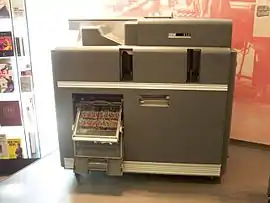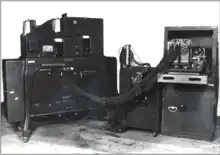IBM 519
The IBM 519 Document-Originating Machine, introduced in 1946, was the last in a series of unit record machines designed for automated preparation of punched cards. Others in the series included the IBM 513 & IBM 514 Reproducing Punch.
 | |
 An IBM 519 Document-Originating Machine with plugboard control panel open (it would be closed during operation). | |
| Type | Unit record equipment |
|---|---|
| Release date | 1946 |
The 519, which was "state of the art for the time",[1] could:
- reproduce all or parts of the information on a set of cards
- "gangpunch" - copy information from a master card into the following detail cards
- print up to eight digits on the end of a card
- compare two decks of cards
- "summary punch" — create punch cards containing summary information provided by a connected accounting machine, such as totals from a group of processed cards
- "mark sense" — detect marks made with an electrographic pencil in designated locations on a punched card and then punch holes corresponding to those marks into the card
- number cards consecutively (an optional feature)
The reproducing, gangpunching, summary punching, and comparing features of the IBM 519 are very similar to those of the IBM 513 and IBM 514.
IBM 513 Reproducing Punch


The IBM 513 Reproducing Punch, like the IBM 514, had some - but not all - of the capabilities included in the IBM 519.[2][3] This model was released circa 1933.[4]
IBM 514 Reproducing Punch

The IBM 514 Reproducing Punch was introduced in February 1949.[5] Like the 513, it had fewer capabilities than the IBM 519. The 514 was withdrawn in 1978.
The identifier "IBM 514" has been partially recycled in the form of "IBM 514 Watt(s) Hot-Swap Power Supply."[6][7]
Capabilities table
| Capability | 513 Repro Punch |
514 Repro Punch |
519 Doc Mach. |
|---|---|---|---|
| Comparing | Yes | Yes | Yes |
| Editing | Yes | Yes | Yes |
| End Printing | — | — | Yes |
| Gangpunching | Yes | Yes | Yes |
| Mark-Sense Punching |
Yes | Yes | Yes |
| Reproducing | Yes | Yes | Yes |
| Summary Punching | Yes | Yes | Yes |
The IBM 513, 514 and 519 all operated at 100 cards per minute,[8] and their operations were directed by a removable control panel that was known as a plugboard.[9] As with other IBM punched card devices that operated as automatic punches, cards are fed "face down, 12-edge first.".[10] (On devices that operated as automatic readers, cards were fed "face down, 9-edge first instead.)
History
Production of the IBM 519 was still going strong in 1956/1957, and production was consolidated to Rochester (for the Americas) and Milan, Italy.[11][12] IBM closed its last punched card manufacturing plant in 1984,[13] nearly a century after Herman Hollerith's 1886 construction of the first card sorting machine.[14]
References

- June Duran Stock (2012). The Twenty-Five Cent Gamble. p. 157. ISBN 978-1477287583.
- Automatic Punches - General Information Manual (PDF). 1959.
- IBM 513 at Columbia's Computing History page
- "IBM1401_ArchivePics.html". ibm-1401.info. Retrieved 2021-11-27.
- "IBM 514".
- "39Y7179 IBM 514-Watts Hot Swap Power Supply for System x226".
- "7000758-0000 IBM 514 Watt Hot-Swap Power Supply. New Pull".
- "View Digitized Material" (PDF). AMhistory.SI.edu (National Museum of American History, Smithsonian Institution). August 26, 1970.
- "IBM Reproducing / Summary Punches".
- Reference Manual - IBM 513, 514 Reproducing Punches (PDF). p. 6. A24-1002-2.
- "Rochester chronology, page 4".
- "IBM Archives: Italy chronology 1950 - 1969".
- Joseph Perkins (July 2, 1984). "IBM Punch-Card Plant Will Close". The Washington Post.
- The New York Times Guide to Essential Knowledge: A Desk Reference. 2011. ISBN 978-0312643027.
{{cite book}}:|work=ignored (help)
IBM manuals:
- IBM (1959). IBM Automatic Punches (PDF). D24-1014-0.
- IBM (1959). IBM Reference Manual: 519 Document-Originating Machine (PDF). A24-1017-0.
External links
- Columbia University Computing History: IBM Reproducing/Summary Punches.
- Photo of IBM 513. It doesn't resemble the 514.
- Photo of IBM 514. Compare to the 519.
- Photo of IBM 519